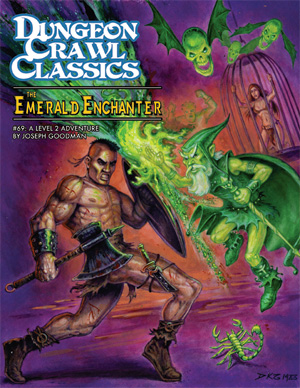Every so often, the old question rises
again: should the GM ever fudge? In examining this question, I am going to
define fudging as changing the outcome of die rolls, or the meaning
of their outcome, during the course of actual play.
It is pretty easy to understand what is
meant by changing the outcome of die rolls:
If you roll 2d6 for damage, and 12 comes up, but you say “10” instead,
you have changed the outcome of die rolls.
Changing the meaning of the outcome
works like this: The opponent had 12 hit
points, the player rolled a “12” on damage, but rather than have the meaning
of the roll (opponent dies) play through, the GM changes the opponent’s
hit points, or gives him a special ability, or does something else behind the
scenes so that the opponent does not die, but can follow a
script which more closely adheres to the GM’s expectations or idea of “fun”. The meaning of the roll’s outcome within
the context of the game has changed.
People can fall on either side of the “fudging”
debate, and many people are divided in how they feel , but I have never
encountered any single instance where I think the game would be improved by
fudging.
Some debunking:
 |
| "Now it doesn't matter what I roll!" |
Not fudging makes the GM a slave to
the dice.
No.
The GM chooses when the dice are rolled, and chooses what dice are
rolled. The dice are still a tool; the
only thing that changes is that the GM is firm in his decision to use that tool
and brave enough to abide by the results, even if they throw him “off script”.
Fudging is the same as prep work.
No.
Prep work – including “on the fly” decisions that the GM has to make to
supply unexpected information within the scenario – is part of
world-building. World-building presupposes
a world in which the players can make decisions, and world-building within the
context of a game presupposes that those decisions matter. Prep work supplies the context for
decision-making, and has nothing to do with fudging.
Fudging is a good tool for developing
GMs to learn the trade.
I strongly disagree.
Consider a case where the GM decides that
Trap A does 3d6 damage, and that 3d6 damage is rolled with a result of 18 against
a character with 14 hp. In this
particular case, having the PC die is not “on script” for the GM – it throws
his “plot” off the rails.
In the case where the GM does not fudge, he
learns to adapt to new situations, and he learns that throwing the plot off the
rails is what players do. It
is what makes their choices meaningful.
He also learns that he needs to consider the possible effects of
anything he throws into the game – if he does not want PCs to die from a failed
save, for example, he should not include save-or-die effects. By seeing the outcome of unexpected game
events, his understanding of what can happen is increased.
In the case where the GM fudges, he learns
that changing the die roll can keep his adventure on the rails, negating the
effects of player choice. He learns that
prep work is not really important – he can just change stuff mid-stream. He does not develop anything outside his
comfort zone, as game events cannot take him there, and he reinforces his “plot”
over the tapestry of context, choice, and consequence which the game becomes
without fudging.
I only fudge when it is important.
Then you are fudging at the worst possible
time.
When it is important is when player choices
matter the most, and you are removing the ability of your players to have their
characters succeed or fail by those choices.
I only fudge when it is not
important.
If it is not important, why not let the
roll stand? Why are you even rolling at
all?
It doesn’t hurt the players if they
don’t know.
Consider trying to learn chess, where your
uncle keeps letting you win no matter how poorly you move. If you think your uncle is doing his best, it
might make you think that you are a great chess player. But it will quickly prove otherwise when you
play someone who isn’t handing you the game.
Did your uncle’s “kindness” in letting you
win help you or hurt you?
So too with the fudging GM.
It’s the same as when you roll a die to make something appear random when it is not.
No it is not.
Imagine a scenario where the GM knows there is no secret door, and rolls the die. The meaning of the outcome (no meaning) is known prior to the roll. The GM is not changing that meaning. The GM is not changing the roll. No fudging is occurring.
It’s my game and I can do what I
want.
Yes.
Yes, it is. And if you can find
even one player who wants the same thing, you should play the game that you
want to play.
But let me quote Mr. Joseph Goodman, if I may, on page 314 of the Dungeon Crawl Classics core rulebook:
- Always roll your dice in public. "Let the dice fall where they may," as the saying goes. The players will learn fear, as they trust in the objectivity of your combat encounters.
- Let the characters die if the dice so dictate it. Nothing is as precious as a PC's life when it can be taken away - and nothing is so unchallenging as a game where the players know the judge will not kill their characters.
Wise words, in my humble opinion.





.JPG)





